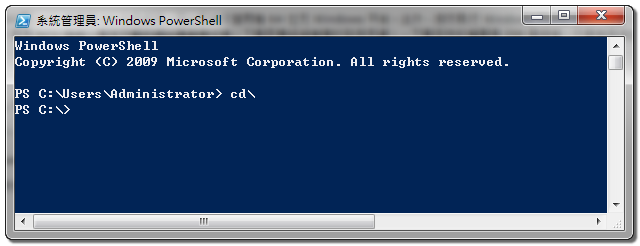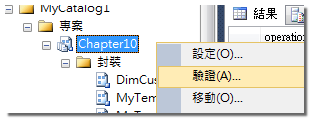有數種方法都可以用來執行封裝,不過這些方法大抵可以被區分二個類別:
- On-demand:依需求使用人工操作的方法來啟動執行。
- Automated:由 SSIS Service 自動啟動執行。
On-Demand SSIS Execution
有時候,有些封裝可能因為 depend on 其他的封裝,或者有特定的需求,所以無法設定自動執行,只有在有需求時才會被啟動執行。 在這種狀況下你就可以透過以下幾種方式來啟動:
- 手動
- 在 SSMS 使用者介面中直接操作。
- 使用 DTExecUI 工具操作
- 程式
- 使用 dtexec 命令
- 使用 TSQL 陳述式
- 使用 Windows PowerShell
- 使用 SSIS Managed API
SSMS
SSMS 同時支援新版(儲存在 SSIS Server)和舊版(儲存在 msdb 或 file system)的封裝。



DTExecUI
執行封裝公用程式(DTExecUI)是 SQL2012 提供的工具程式,用來執行舊版封裝,不支援新版(2012)的封裝。它的程式位置在:(僅有32-bit版本)
C:\Program Files (x86)\Microsoft SQL Server\110\Tools\Binn\ManagementStudio

程式介面:

DTExecUI.exe 這個工具只有 32 位元版,如果只能使用 64 位元的環境,必須使用另外一個工具(dtexec.exe),不過它是屬於命令列工具,沒有UI。
TSQL
接下來的幾個方法都可算是可程式化的啟動封裝,使用可程式化啟動封裝,系統通常會經由以下幾個步驟:
- create a new execution operation
- set execution properties
- start the execution : 預設系統會以非同步的方式啟動封裝,也就是封裝被呼叫後,控制權即回到原先呼叫者。
DECLARE @execution_id BIGINT; DECLARE @use32bitruntime BIT = CAST(0 AS BIT); DECLARE @logging_level INT = 1; EXEC catalog.create_execution @folder_name = N'MyCatalog1', @project_name = N'Chapter10', @package_name = N'Staging.dtsx', @use32bitruntime = @use32bitruntime, @reference_id = NULL, @execution_id = @execution_id OUTPUT; EXEC catalog.set_execution_parameter_value @execution_id, @object_type = 50, @parameter_name = N'LOGGING_LEVEL', @parameter_value = @logging_level; EXEC catalog.start_execution @execution_id;
更多與 SSIS Catalog 相關的 Store Procedures 請參考 MSDN:Stored Procedures (Integration Services Catalog)
Windows PowerShell
Before SSIS packages can be executed by using Windows PowerShell, the SSIS management assembly must be loaded. Then the operation is prepared and executed, as described in the TSQL section.
執行 Windows PowerShell:
- 在『開始』的『執行』交談窗輸入 powershell 或 Windows PowerShell。

- 在任何『命令提示字元』視窗的命令提示符號輸入 powershell。

範例:
#-- Load the SSIS Management Assembly
$assemblyLoad = [Reflection.Assembly]::Load("Microsoft.SqlServer.Management.IntegrationServices , Version=11.0.0.0,Culture=neutral, PublicKeyToken=89845dcd8080cc91")
#-- Create a connection to a SQL Server instance
$connectionString = "Data Source=VITO-2011W7\SQL2012_DB1; Initial Catalog=master; Integrated Security=SSPI; "
$connection = New-Object System.Data.SqlClient.SqlConnection $connectionString
#-- Instantiate the SSIS object
$ssis = New-Object Microsoft.SqlServer.Management.IntegrationServices.IntegrationServices $connection
#-- Instantiate the SSIS package
$catalog = $ssis.Catalogs["SSISDB"]
$folder = $catalog.Folders["MyCatalog1"]
$project = $folder.Projects["Chapter10"]
$package = $project.Packages["Staging.dtsx"]
#-- Set package parameter(s)
$package.Parameters["para1"].Set( [Microsoft.SqlServer.Management.IntegrationServices.ParameterInfo+ParameterValueType]::Literal, "parameter value")
$package.Alter()
#-- Execute SSIS package ($environment is not assigned)
$executionId = $package.Execute("false", $environment)
SSIS Managed API
PowerShell 透過叫用來啟動封裝,若要直接存取 SSIS object 就必須透過 SSIS API ,這些 API 定義在Microsoft.SqlServer.Management.IntegrationServices 命名空間
範例:
using System;
using Microsoft.SqlServer.Management.IntegrationServices;
using SMO = Microsoft.SqlServer.Management.Smo;
…
// Create a connection to a SQL Server instance
SMO.Server ssisServer = new SMO.Server("VITO-2011W7\SQL2012_DB1");
Console.WriteLine("Connected to:\t\t" + ssisServer.Name);
// Instantiate the SSIS object
IntegrationServices ssis = new IntegrationServices(ssisServer);
// Instantiate the SSIS package
Catalog catalog = ssis.Catalogs["SSISDB"];
CatalogFolder folder = catalog.Folders["MyCatalog1"];
ProjectInfo project = folder.Projects["Chapter10"];
PackageInfo package = project.Packages["Staging.dtsx"];
Console.WriteLine("Selected package:\t" + System.IO.Path.Combine(catalog.Name, folder. Name, project.Name, package.Name));
// Set package parameter(s)
package.Parameters["para1"].Set( ParameterInfo.ParameterValueType.Literal, "parameter value" );
package.Alter();
catalog.ServerLoggingLevel = Catalog.LoggingLevelType.None;
// Execute SSIS package
package.Execute(false, null);
PS1.若是在 VS2010 底下,請自行加入以下參考組件。
C:\Windows\assembly\GAC_MSIL\Microsoft.SqlServer.Management.IntegrationServices\11.0.0.0__89845dcd8080cc91\Microsoft.SqlServer.Management.IntegrationServices.dll C:\Windows\assembly\GAC_MSIL\Microsoft.SqlServer.Management.Sdk.Sfc\11.0.0.0__89845dcd8080cc91\Microsoft.SqlServer.Management.Sdk.Sfc.dll
PS2.若是要存取 SQL Server 中的管理物件,可使用 Server Management Objects。((Microsoft.SqlServer.Management.Smo).)
DTExec
DTExec utility is :
- a command-line utility
- can execute packages stored in the SSISDB catalog and the older SSIS service (that is, stored in the msdb system database or in the managed file system).
dtexec /f "C:\mypackage.dtsx"
PS. DTExecUI cannot be used to execute packages stored in the SSISDB catalog.
Automated SSIS Execution
most SSIS package are:
- scheduled for automatic execution
- performed at times when systems are not being used, for instance, at night
SQL Server Agent
SQL Server Agent 是 SQL Server 中的一個元件,主要功用就是用來協助自動化執行在 SSIS Server 上的封裝作業。 SQL Server Agent 使用下列物件來定義要執行的工作,何時執行工作以及報告工作成功或失敗的方式。


作業與作業步驟(Jobs and Job Steps)
- Jobs is the principal unit of work in SQL Server Agent processes
- A Job serves as a container for job steps, which represent the actual operations.
作業步驟類型:

排程(Schedules)
在 SQL Server Agent 上的作業中,是透過「排程」(Schedule) 來指定作業的執行時間。 排程可使用以下定義來設定條件:
- 每當 SQL Server Agent 啟動時
- 每當電腦的 CPU 使用率達到您定義為閒置的等級時。
- 某個特定的日期和時間。
- 執行循環排程時。
警示(Alert)
「警示」是針對特定事件的自動回應。可用來回應下列條件之一:

操作員(Operator)
「操作員」是警示設定中,用來接收通知的對象,SQL Server 可以透過下列一或多種方式,通知操作員發生警示:
- 電子郵件
- 呼叫器 (透過電子郵件)
- net send
Monitoring SSIS Execution
通常我們會針對部署到 SSIS 目錄中的專案或封裝進行執行或驗證。 這些過程都會被記錄下來,也可以透過系統檢視來進行追縱。
Operations
當 SSISDB 中的封裝或專案被執行或被驗證時,都會建立一筆作業(Operations),用來記錄這個操作行為。 這些作業的記錄都會被反應在 catalog.operations 檢視表中。底下三個檢視表,都是用來檢視與作業相關的記錄:
- catalog.operations :Displays the details of all operations in the Integration Services catalog.
- catalog.operation_messages :Displays messages that are logged during operations in the Integration Services catalog.
- catalog.extended_operation_info :Displays extended information for all operations in the Integration Services catalog.
作業的狀態(Operation Status)
每個作業隨著不同的執行階段,其狀態包含以下九種可能:
- 1:已建立(Created)
- 2:執行中(Running)
- 3:已取消(Canceled)
- 4:失敗(Failed)
- 5:暫止(Pending)
- 6:意外結束(Ended unexpectedly)
- 7:成功(Succeeded)
- 8:停止(Stopping)
- 9:已完成(Completed)

Validations
在 SSIS 目錄中,你可以針對專案或封裝進行驗證(Validations),用以檢驗專案或封裝中的種種設定。 你可以透過 catalog.validations 來查看每次驗證的資料。
專案驗證(project validations):

封裝驗證(package validations):

Executions
通常在 SSIS 目錄中的專案或封裝,最常被操作的行為就是執行(Executions)。 封裝在執行前,都會先進行驗證,驗證通常才會開始執行。
Logging Levels
前面提過,在 SSIS 中的作業,都會被記錄下。你可以針對資訊的詳細度,來設定記錄模式。 SSISDB 支援以下幾種不同的記錄模式:
- None:關閉記錄功能。 只記錄封裝執行狀態。
- Basic:記錄所有事件,自訂和診斷事件除外。這是預設值。
- Performance:只記錄效能統計資料,以及 OnError 和 OnWarning 事件。
- Verbose:記錄所有事件,包括自訂和診斷事件。
SSIS Monitoring in SSMS
若要監看 SSIS 的執行狀況,在 SSMS 之中就有方便的功能,有些使用報表,有些使用內建檢視表。 例如,除了上面提到的幾個檢視表外,你也可以使用以下幾個檢視表來查看與封裝執行相關的資訊:
- catalog.executions :顯示 Integration Services 目錄中封裝的執行執行個體。 以 [封裝執行工作] 執行的封裝會使用與父封裝的相同執行執行個體來執行。
- catalog.execution_data_statistics :每當資料流程元件傳送資料至特定封裝執行的下游元件,此檢視就會顯示一個資料列。 此檢視中的資訊可用來計算元件的資料輸送量。
- catalog.execution_data_taps :顯示執行中定義之每個資料點選的資訊。
- catalog.execution_component_phases :顯示資料流程元件在每個執行階段所花費的時間。
若要查看報看,你只要先點選目錄中的節點(catalog, project, package, or environment),就可右鍵選單中找到報表。



沒有留言:
張貼留言